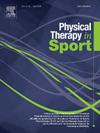Altered landing strategy during vertical jump tasks in elite volleyball players with patellar tendinopathy
IF 2.2
3区 医学
Q1 REHABILITATION
引用次数: 0
Abstract
Objective
To describe the biomechanical strategies during the landing phase of vertical jumps in volleyball players with or without patellar tendinopathy.
Design
Cross-sectional observational study.
Setting
Field-based study.
Participants
Twenty-three elite volleyball players, 9 of whom where symptomatic for patellar tendinopathy (PT; Victorian Institute of Sport Assessment-Patella (VISA-P) score ≤80).
Main outcome measures
Participants performed 4 types of vertical jumps: squat jump (SJ), countermovement jump without/with hands (CMJNH/CMJWH), and drop jump (DJ). Landing biomechanics were recorded using inertial measurement units and force platforms.
Results
The PT group exhibited greater maximal knee flexion angles during CMJNH and DJ (p = 0.02 and p = 0.02; Hedges' g = −0.92 and −1.01, respectively), along with increased knee sagittal plane range of motion across CMJNH, CMJWH, and DJ (p = 0.007, p = 0.04, and p = 0.05; Hedges' g = −1.16, −0.85, and −0.88, respectively). Additionally, the PT group demonstrated higher rates of velocity decrease during CMJWH and DJ (p = 0.015 and p = 0.005; Hedges’ g = −0.97 and −1.17, respectively).
Conclusions
This study highlighted key knee joint kinematics differences in PT athletes during jump landing. Future applications may include early detection of the pathology, before functional impairments develop.
精英排球运动员髌骨肌腱病变在垂直跳跃任务中着陆策略的改变
目的探讨有或无髌骨肌腱病变排球运动员垂直起跳落地阶段的生物力学策略。设计横断面观察性研究。SettingField-based研究。研究对象:23名优秀排球运动员,其中9名有髌骨肌腱病变(PT;victoria Institute of Sport assessment -髌骨(VISA-P)评分≤80)。参与者进行了4种类型的垂直跳跃:蹲跳(SJ),无手/有手反动作跳(CMJNH/CMJWH)和落体跳(DJ)。使用惯性测量装置和力平台记录着陆生物力学。结果PT组在CMJNH和DJ时膝关节最大屈曲角度较大(p = 0.02和p = 0.02;Hedges' g分别= - 0.92和- 1.01),以及CMJNH, CMJWH和DJ的膝关节矢状面运动范围增加(p = 0.007, p = 0.04和p = 0.05;对冲的g分别= - 1.16,- 0.85和- 0.88)。此外,PT组在CMJWH和DJ期间速度下降率更高(p = 0.015和p = 0.005;对冲的g分别= - 0.97和- 1.17)。结论本研究突出了PT运动员在起跳落地时膝关节运动学的关键差异。未来的应用可能包括在功能损伤发展之前的病理早期检测。
本文章由计算机程序翻译,如有差异,请以英文原文为准。
求助全文
约1分钟内获得全文
求助全文
来源期刊

Physical Therapy in Sport
医学-康复医学
CiteScore
4.50
自引率
8.30%
发文量
125
审稿时长
39 days
期刊介绍:
Physical Therapy in Sport is an international peer-reviewed journal that provides a forum for the publication of research and clinical practice material relevant to the healthcare professions involved in sports and exercise medicine, and rehabilitation. The journal publishes material that is indispensable for day-to-day practice and continuing professional development. Physical Therapy in Sport covers topics dealing with the diagnosis, treatment, and prevention of injuries, as well as more general areas of sports and exercise medicine and related sports science.
The journal publishes original research, case studies, reviews, masterclasses, papers on clinical approaches, and book reviews, as well as occasional reports from conferences. Papers are double-blind peer-reviewed by our international advisory board and other international experts, and submissions from a broad range of disciplines are actively encouraged.
 求助内容:
求助内容: 应助结果提醒方式:
应助结果提醒方式:


